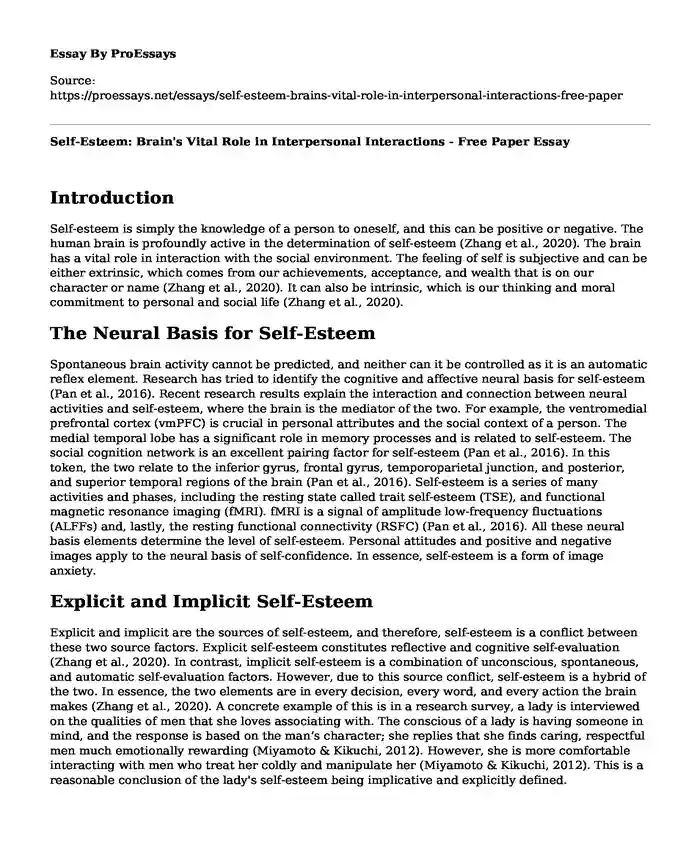Introduction
Self-esteem is simply the knowledge of a person to oneself, and this can be positive or negative. The human brain is profoundly active in the determination of self-esteem (Zhang et al., 2020). The brain has a vital role in interaction with the social environment. The feeling of self is subjective and can be either extrinsic, which comes from our achievements, acceptance, and wealth that is on our character or name (Zhang et al., 2020). It can also be intrinsic, which is our thinking and moral commitment to personal and social life (Zhang et al., 2020).
The Neural Basis for Self-Esteem
Spontaneous brain activity cannot be predicted, and neither can it be controlled as it is an automatic reflex element. Research has tried to identify the cognitive and affective neural basis for self-esteem (Pan et al., 2016). Recent research results explain the interaction and connection between neural activities and self-esteem, where the brain is the mediator of the two. For example, the ventromedial prefrontal cortex (vmPFC) is crucial in personal attributes and the social context of a person. The medial temporal lobe has a significant role in memory processes and is related to self-esteem. The social cognition network is an excellent pairing factor for self-esteem (Pan et al., 2016). In this token, the two relate to the inferior gyrus, frontal gyrus, temporoparietal junction, and posterior, and superior temporal regions of the brain (Pan et al., 2016). Self-esteem is a series of many activities and phases, including the resting state called trait self-esteem (TSE), and functional magnetic resonance imaging (fMRI). fMRI is a signal of amplitude low-frequency fluctuations (ALFFs) and, lastly, the resting functional connectivity (RSFC) (Pan et al., 2016). All these neural basis elements determine the level of self-esteem. Personal attitudes and positive and negative images apply to the neural basis of self-confidence. In essence, self-esteem is a form of image anxiety.
Explicit and Implicit Self-Esteem
Explicit and implicit are the sources of self-esteem, and therefore, self-esteem is a conflict between these two source factors. Explicit self-esteem constitutes reflective and cognitive self-evaluation (Zhang et al., 2020). In contrast, implicit self-esteem is a combination of unconscious, spontaneous, and automatic self-evaluation factors. However, due to this source conflict, self-esteem is a hybrid of the two. In essence, the two elements are in every decision, every word, and every action the brain makes (Zhang et al., 2020). A concrete example of this is in a research survey, a lady is interviewed on the qualities of men that she loves associating with. The conscious of a lady is having someone in mind, and the response is based on the man’s character; she replies that she finds caring, respectful men much emotionally rewarding (Miyamoto & Kikuchi, 2012). However, she is more comfortable interacting with men who treat her coldly and manipulate her (Miyamoto & Kikuchi, 2012). This is a reasonable conclusion of the lady's self-esteem being implicative and explicitly defined.
Social Cognition
Social cognition is defined as how people evaluate, memorize, and apply actions and words from others. This is the prospect of information about self and others in the social context and encompasses cognitive fundamentals and the roles that the data plays in our social environment (Cherry, 2019). Self-esteem is the gear to social cognition by people and determines the channel of interactions (Cherry, 2019). A person having low self-esteem will have awkward characteristics of incompetency, unlovable, and fear (Cherry, 2019). Low self-esteem causes poor social cognition, resulting in depression and social pain from the social environment. A highly self-esteemed person will have a good social cognition to find worthwhile space to deal with adversities. Such self-esteem gains a good social perception a feeling of self-worth and competency of personal attributes (Cherry, 2019). The results are positive, including anxiety of joy, happiness, and the urge to have more social interactions (Cherry, 2019).
References
Cherry, K. (2019). Social Cognition and the World Around Us. Verywell Mind. Retrieved 22 August 2020, from https://www.verywellmind.com/social-cognition-2795912.
Miyamoto, R., & Kikuchi, Y. (2012). Gender differences of brain activity in the conflicts based on implicit self-esteem. PLoS One, 7(5), e37901.
Pan, W., Liu, C., Yang, Q., Gu, Y., Yin, S., & Chen, A. (2016). The neural basis of trait self-esteem revealed by the amplitude of low-frequency fluctuations and resting state functional connectivity. Social Cognitive and Affective Neuroscience, 11(3), 367-376.
Zhang, L., Yu, Q., Zhang, Q., Guo, Y., & Chen, J. (2020). The relationship between explicit self-esteem and subjective well-being: The moderating effect of implicit self-esteem. The Journal of General Psychology, 147(1), 1-17.
Cite this page
Self-Esteem: Brain's Vital Role in Interpersonal Interactions - Free Paper. (2023, Nov 18). Retrieved from https://proessays.net/essays/self-esteem-brains-vital-role-in-interpersonal-interactions-free-paper
If you are the original author of this essay and no longer wish to have it published on the ProEssays website, please click below to request its removal:
- Ways in Which Societies Depend on Fear as a Control Mechanism Essay
- Paper Example on Concept of Sociology of Emotions
- Informative Speech on Communication Example
- Essay on Nurse Qualification Impact: Burnout & Career Change?
- Essay Example on Piaget's Theory of Cognitive Development: Impact on Child's Thinking
- Essay Example on Teen Driving: 14% of Accidents Caused by Inexperienced Drivers
- The Essence of Effective Leadership: Key Traits and Characteristics - Essay Sample







